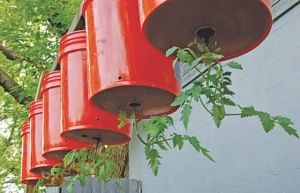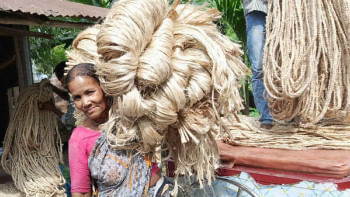Growing tomatoes the cool way - upside down
Growing tomatoes is a regular feature of our winter cultivation. All the gardens are already adorned with this vegetable (technically, it is a fruit!) either at the ripening stage or having already yielded the first phase of their production. It is not yet too late to have another go at tomato cultivation, but in a different way. With limited space and time, we the urban gardeners are always ready to do things differently. Let's try another way of cultivating tomatoes -- upside-down (let's call it USDTG).
Albert Newton's 'theory of gravity' works well here, because of the vertical growing method, USDTG uses the power of gravity. Water is poured into the top of the bag or planter. Gravity pulls the water and nutrients directly to the roots; particularly USDTG in bags also lends the greenhouse effect, allowing the root system to expand easily and in a healthy manner.
For your USDTG gardening we need lighter pots/containers (tin/plastic, or sacks), cement bags (two-three together) to make the container strong enough to hold the plant firmly in its upside-down condition. We need to have strong loops to hang the bags or pots when filled with soil. Select the garden area with access of enough sunlight and air flow. Now make the air-drainage holes around the body of the pots and several at the bottom of the containers. If you intend to use sacks, make some holes around the body of the sacks. We can also use the large-sized water cans. Buy medium-range wire/ropes (tar/dori -- available in hardware stores), calculating the requirement of the hanging ring and loops around the pots (to ensure sealing the opening side of the pot and plants).
There are two ways of USDTG -- one is the regular way of planting: first do the planting as we usually do. Collect healthy, young saplings of 2-3 weeks and plant a maximum of two in one pot/bag, nurture them for two weeks or until they reach 6-12 inches high, then close the lid tight with wire or so after putting net bags or net type of material to prevent fall/leakage of soil while in upside-down position. If you want to have your own saplings, collect the seeds of your choice of several varieties available in the renowned nurseries.
Nowadays cherry tomatoes are becoming popular for their size, shape and taste. There are imported or high-bred sun-gold types available at all outlets. Sow the seeds in a well-manured/well-mixed soil, cover them for a few days and protect the area from all types of harm.
When the new seedlings pops up, remove the cover and take regular care. Allow them to grow with sufficient space until they are 6-10 inches tall. Now shift the healthy ones to the pots or sacks and take the next step. Let them be stable in the new home for one-two weeks. Your pots are then ready to hang. Water the plants regularly. When the plants are well-adjusted and getting ready to flower, pour some water lightly mixed with fertiliser and keep nurturing the plants with love and care. After a while the look will be bushy -- prune the extra branches, keeping the strong few to grow well. Now you start seeing the tiny buds which within a few days will turn into tomatoes -- gradually from green to matured light yellow and then to red!
Advantages of USDTG are manifold. It suits our apartment-based and small-spaced life, allows multiple use of space, can be hung on the outer side of the balcony, and other types of planting could be done easily at the base or at different layers of the small space. This method ensures better circulation of air and sunlight around the container, thus the chances of soil-borne insects, diseases and weeds are decreased significantly. USDTG also keeps the area clean; there is no need for supporting staking as the plant grows nicely around the pots. You can ignore or manage some of the minor disadvantages. Watering is a problem sometimes, so you need to adopt different mechanism to prevent the pots from drying out prematurely. Applying fertiliser is also a bit cumbersome but it can be managed with a little innovation -- dilute the fertiliser (small amount of TSP or khoyil), mix with water dripped through a pipe or so. Sometime strong winds can harm the plants or damage the total system. So you need to be extra vigilant all the time, only then you can enjoy the fun of USDTG!
Problems you may face: insects, fungus/grey leaves, damp weather and bad fruiting, rotting of roots, early fall of the young buds/fruits and cracking of tomatoes before they ripen, etc. To prevent the disease, select healthy, green saplings -- let the stronger branches grow, remove the new branches coming in between those. This will allow the main stems to grow strong and produce flowers and fruits. The moisture of the soil of pot-planted saplings need to be regularly maintained, make the soil clean, and the plants need adequate sun and air flow -- take out the affected part carefully. If the weather is too cold or wet, the plants may be attacked by fungus or other diseases. If required, take help from the nearby nursery.
Do it in a cool way and surprise your friends and neighbours. I am sure they will start the USDT planting soon.
Please feel free to send me emails to share your thoughts, feedback, photos of your garden, or to tell your story; or ask a question on gardening issues. Email: [email protected]


 For all latest news, follow The Daily Star's Google News channel.
For all latest news, follow The Daily Star's Google News channel. 



Comments